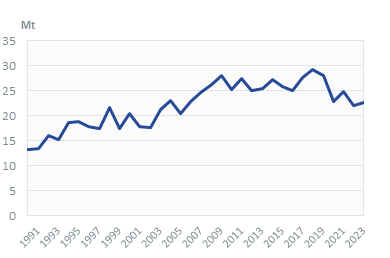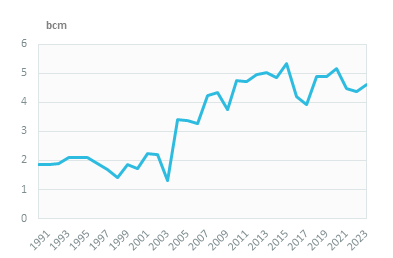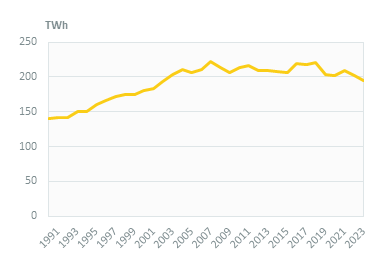-
-
 Energy and Climate Databases
Energy and Climate Databases- The most comprehensive and up-to-date annual energy database.
- Monitoring of technology providers in H2 supply chain.
- Monthly energy data on key energy markets.
- The most reliable and up-to-date power generation database.
- The essentials of LNG trade at your fingertips.
- Global monitoring of new and existing refineries.
- Analyse energy consumption and efficiency trends at world level. Benchmark countries.
- Have your database developed by a recognised expert of both energy and IT.
-
 Energy - Climate Forecasts
Energy - Climate Forecasts- Instant access to energy and emissions forecasts.
- Strategic, annual wholesale price projections backed by Enerdata's energy modelling expertise and our globally recognised POLES model.
- Wedges module showing a breakdown of the levers enabling to reduce emissions between two scenarios.
- Unique, independent projections of consumption by end-use.
- GHG Marginal Abatement Cost Curves.
- Benefit from proven models to draw your own energy scenarios and anticipate tomorrow’s challenges.
-
 Market Intelligence
Market Intelligence- 110 Energy and climate country reports
- A newsletter to receive the latest updates on evolving technologies and policies.
- Global energy news and analyses curated daily.
- Enerdata’s experts bring you the essentials about your market and competitors.
-
-
-
 Market Analysis
Market Analysis- Understanding key consumption trends and drivers across sectors.
- Granular and exclusive insight to address the most pressing business and strategic issues.
- Expertise in strategic and business intelligence, with fine-tuning to the market’s specificities.
-
 Energy - Climate Scenarios
Energy - Climate Scenarios- Providing the outlook of an energy commodity in mid to long term time horizons.
- Sector and driver specific energy demand forecasting.
- Assess the evolution of energy prices on the international and regional markets, as well as end-users prices.
- Enerdata guides you through pathways to reach climate targets.
- Supporting local authorities in their decarbonisation strategies.
-
 Climate Strategy and Policy Evaluation
Climate Strategy and Policy Evaluation- Cutting-edge quantitative tools and relevant indicators to monitor and evaluate evolutions on worldwide energy markets.
- Analysis of the most cost-effective options to reduce emissions.
- Quantified simulation and analysis of pledges for climate change negotiations.
- Breakdown of carbon markets and evaluation of the climate change impacts on the carbon price.
- Enerdata guides you on the most beneficial policy or investment options.
- Turning climate objectives into concrete action plans.
-
 Training
Training- Understand different policy targets and measures on energy efficiency.
- How to measure energy savings?
- Energy Forecasting is a 2 days training to learn to design and interpret energy forecasts.
- Energy statistics training allowing to create energy balance with supply, transformation and consumption and understanding the international energy statistics regulations.
- Initiation to EnerMED level 1is the training to approach on the most powerful energy demand forecasting model.
-
-
Resource Centre
South Africa Key Figures
- Population:
- 60.8 million
- GDP growth rate:
- 0.60 %/year
- Energy independence:
- 100%
Data of the last year available: 2023
- Total consumption/GDP:*
- 75.8 (2005=100)
- CO2 Emissions:
- 6.92 tCO2/capita
- Rate of T&D power losses:
- 11.2%
* at purchasing power parity
View all macro and energy indicators in the South Africa energy report
South Africa Energy News
View all news, archive your new and create your own daily newsletters only on your topics/countries of interest with Key Energy Intelligence
South Africa Energy Research
Benefit from up to 2 000 up-to-date data series for 186 countries in Global Energy & CO2 data
A data overview is available in the global energy statistics app
South Africa Total Energy Consumption
Total energy consumption per capita peaked in 2008 at 3 toe per capita and then progressively decreased to 2.1 toe per capita in 2023 (over 4 times the average energy consumption per capita in the other Southern African countries: Botswana, Eswatini, Lesotho, Namibia). Electricity consumption per capita peaked at 4 500 kWh in 2007 before decreasing to 3 200 kWh in 2023 (around 9 times the value of other Southern African countries).
Total energy consumption has been decreasing since 2019 (by 2.2%/year).
Interactive Chart South Africa Total Energy Consumption
Benefit from up to 2 000 up-to-date data series for 186 countries in Global Energy & CO2 data
View the detailed fondamentals of the market at country level (graphs, tables, analysis) in the South Africa energy report
South Africa Crude Oil Production
Total oil production has decreased by 7% per year since 2015, reaching 3 Mt in 2023. It mostly comes from synthetic fuels of the Secunda coal-to-liquid facility (Sasol, 150 kb/d), as conventional production of crude oil is marginal. Another plant, Mossel Bay GTL (PetroSA, 45 kb/d), is off since 2020 due to a lack of gaseous feedstock.
Interactive Chart South Africa Crude Oil Production
Benefit from up to 2 000 up-to-date data series for 186 countries in Global Energy & CO2 data
Additionally, for more detailed information on refineries, you can request a sample of our EMEA Refineries Dataset
South Africa Oil Products Consumption
Oil consumption increased by 3% in 2023, after a 6%/year reduction since 2019; before that, it remained roughly stable at around 27 Mt between 2011 and 2019.
Transport accounts for 66% of that consumption, followed by industry (including non-energy uses) with 24%, residential-services-agriculture (10%), and the hydrocarbon sector (less than 1%).
Graph: OIL CONSUMPTION (Mt)

Graph: OIL CONSUMPTION BREAKDOWN BY SECTOR (2023, %)
Interactive Chart South Africa Refined Oil Products Production
Benefit from up to 2 000 up-to-date data series for 186 countries in Global Energy & CO2 data
Additionally, for more detailed information on refineries, you can request a sample of our EMEA Refineries Dataset
South Africa Natural Gas Consumption
Gas consumption increased by 5% in 2023 to 4.6 bcm, following a decrease of 3% in 2022 and a significant drop of 13% in 2021; before that, it was quite stable between 2015 and 2020. Previously, it rose with strong fluctuations, at an average pace of 8%/year between 2000 and 2015.
Gas is mainly used in industry (51%) and to produce fuels in the gas-to-liquids plant (48%).
Graph: NATURAL GAS CONSUMPTION (bcm)

Interactive Chart South Africa Natural Gas Domestic Consumption
Benefit from up to 2 000 up-to-date data series for 186 countries in Global Energy & CO2 data
Additionally, for more detailed information on the LNG trade, you can request a sample of our EMEA LNG Trade Dataset
South Africa Coal Consumption
Coal consumption has dropped by 3%/year since 2019, reaching 166 Mt in 2023. This represents the lowest consumption since 2001. Between 2008 and 2019, coal consumption fluctuated around 190 Mt.
Power generation absorbed 60% of the coal consumed in 2023, followed by coal transformation (26%), industry (10%), and the residential and services sectors (4%).
Graph: COAL CONSUMPTION (Mt)

Graph: COAL CONSUMPTION BREAKDOWN BY SECTOR (2023, %)
Interactive Chart South Africa Coal and Lignite Domestic Consumption
Benefit from up to 2 000 up-to-date data series for 186 countries in Global Energy & CO2 data
View the detailed consumption trends at country level (graphs, tables, analysis) in the South Africa energy report
South Africa Power Consumption
Electricity consumption decreased by 4% to 195 TWh in 2023, which is in line with the downward trend observed since 2018 (-2.5%/year). It remained stable between 2005 and 2018, fluctuating between 204 and 221 TWh.
Industry is the main electricity consumer (47%), followed by the residential sector (22%) and services (18%).
Graph: ELECTRICITY CONSUMPTION (TWh)

Graph: ELECTRICITY CONSUMPTION BREAKDOWN BY SECTOR (2023, %)
South Africa Renewable in % Electricity Production
The IRP2023 targets the addition of 8.2 GW of wind and solar by 2030 in relation to 2022, made up of 4.5 GW of wind and 3.7 GW of solar. Wind should account for 9% of installed capacity in 2030 and solar for 7%.
The 2023 and 2024 governmental budgets include a ZAR 9bn (US$491m) tax incentive programme to support private investments (business and households) in wind, concentrated solar, hydro under 30 MW, biomass, and solar PV projects over 1 MW.
Interactive Chart South Africa Share of Renewables in Electricity Production (incl hydro)
Benefit from up to 2 000 up-to-date data series for 186 countries in Global Energy & CO2 data
South Africa CO2 Fuel Combustion/CO2 Emissions
In its updated NDC (2021), South Africa aims to limit GHG emissions to 398-510 MtCO2eq in 2025 and to 350-420 MtCO2eq in 2030 (aligned with 1.5 and 2 degrees of global warming, respectively). The upper end of the 2030 target has been reduced by 32% compared to the first NDC (2015). According to the 8th national inventory, GHG emissions reached 469 MtCO2eq in 2020 excluding LULUCF, of which 80% was CO2 (60% from the energy industries and 16% from transport). They have decreased by 12.5% since a peak at 536 Mt in 2012.